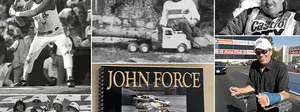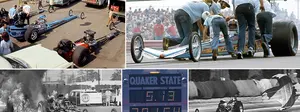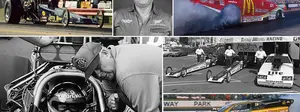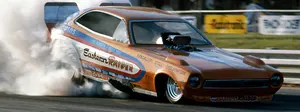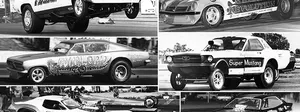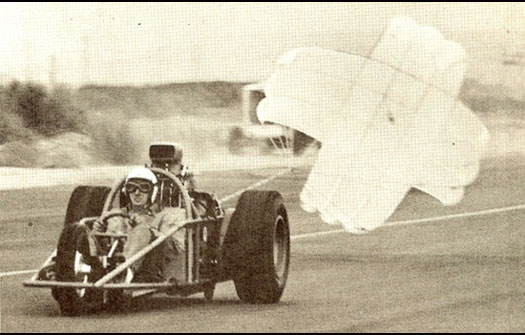

Thanks for filling in the blanks
I could have entitled this entry "DRAGSTER Insider readers to the rescue … again" because y'all came through with flying colors following my Fun with Fotos article here a week ago. I had info on some of the pics presented and asked for the DI faithful to fill in the blanks, and you responded with the avalanche below. From the e-mail I get and the all-star list of names I'm told who read my humble bit of biweekly drivel, I bet we cover a vast majority of the history of the sport, which is what makes it so much fun to read (and write).
Okay, your turn, guys …
 |
Fred Fischbach had no problem ID-ing the owner of the blown Austin-Healey as his old friend Norm Cowdrey. "This is from the mid- to late '60s," he wrote. "Norm had the chassis built in
"Sometimes when there was no race for Norm to go to, he would unbolt the blower and put it on his Corvette – underdriven, of course -- and we'd go tooling around the Valley; no big deal today, but then -- big deal. Too much fun."
Bill Holland added of the car, "Cowdrey normally did well in one of the eliminator categories at San Fernando Dragway, where the photo was taken. Norm went on to campaign the Blue Fox Camaro Funny Car. He later was involved in a few TAFC deals, one of which was driven to a Wally win at

 |
Being able to ID a car is one thing, but being able to figure out at which track a photo was taken always requires some skill. Bill Carrell was "99.9 percent sure" that the Shower Power photo was taken at Thompson Drag Raceway in Thompson, Ohio, because of "the trees and their proximity to the track; the signage with roads identified in that area, specifically Ridge Road and Mayfield; I worked there and can tell a shot of that track from almost any angle; and where else but Ohio?"
Dawn Mazi-Hovsepian,

I got a lot of feedback on the three-wheel dragsters along with solid IDs on both. Cliff Morgan and John Pecora wrote to say that the front-engine car belonged to Kenny Ellis, and Steve Gibbs wrote that the rear-engine car was the Cook Bros., Jahns, and Hedges entry driven by Jeff Jahns.
Morgan noted that "Ellis was the most famous with an almost conventional front-motor car, which had a tendency to wheelie down the track, especially in the lights." Added Pecora, "Ken is still at it doing fabrication but is stricken with cancer and is fighting with all he has. This photo, I think, is of the third three-wheeler. I built a complete replica of this car for him and gave it to him and son. His son wants to show it off at various events."
Of the other car, Gibbs reminisced, "One of the things that made the sport so appealing in the '50s and '60s was that you never knew what would show up next. The rules were wide open. [This is ] one of the cars that was nonconforming in just about every aspect. It was a rear-engine sidewinder, three-wheeler, using air jacks (à la Pete Robinson) to launch the car ... all with a fuel-burning small Dodge Hemi. It had a body but was not used much. The car had a short life and crashed at 'the Beach.' Driver Jahns got out of it, but it rearranged his nose. I can't imagine how today's tech guys would react if this car were to show up again."
|
|
|

 |
Bob Post, author of High Performance, the unofficial bible of drag racing historians everywhere, said he believes this is Bill Martin of
In looking at this picture, Morgan added that the body was probably one of the many that came from a fuel tank from an airplane. "Lots of guys used those tanks to create cars for the dry lakes after World War II, both front- and rear-engined versions, and some found their way to the drags. This car used the front section, and I can see the bottom of the car under the engine. Interesting design, and the car looked 'high tech' for its time, probably 1953-54."

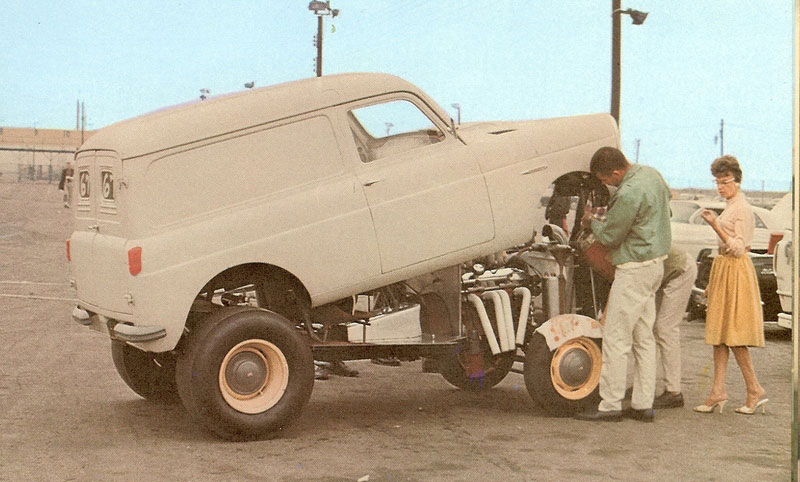 |
Gibbs also was handy for the ID on this great old photo. "This is the gasser of Dale (he) and Al (her) Kersh, of
Byron Stack of Gasser Madness confirmed that this is the Kersh Family A/Gasser. "Memory tells me it was powered by a Mopar wedge motor with homebuilt injection," he wrote. "It was a very cool piece and fun to watch."

 |
Neal Larson of
"The picture was taken around 1961 or 1962," he wrote. "The car's last race was in
"Jack was a member of the Barons Racing team from

 |
The great photo of "Big John" Mazmanian's 'Cuda with four-wheel liftoff in Indy was shot by Larry "Max" Maxwell of L&M Photos according to Norman Blake, a pretty fine lensman in his own right (who promises to send me his Five Favorite Fotos soon; remember that early DI feature?). Also, Bill Burns, in responding to my observation that the car was battle-scarred, wrote, "I’m not positive, but I believe the battle scars are from the famous 'net' at the end of Green Valley Raceway in

Dan Tuttle dropped me a line to say that Noel Black's twin-engine car actually wasn't a Top Fuel car but that it was a Bonneville Streamliner nicknamed the Rhinoceros, in which he was later killed. "Reportedly, the car was well above 400 when it lost its belly pan," he said. "Apparently [this photo] was another test."
Fabed quarter-mile photog Steve Reyes, who shot the pic below right, tells me the unique-looking car was photographed at Sacramento Raceway.
I was able to find mention of the car in "Landspeed Louise" Noeth's book, Bonneville: The Fastest Place on Earth. Here is a picture of the car with bodywork taken by George Callaway. Noeth says the Rhinoceros name came from the body bumps to accommodate the engines.
Drag racing historian Bret Kepner tells me that the car was created by Black and partner Bert Peterson at their B&N Automotive shop and was never designed to be a dragster at all. "It was purely a land-speed record vehicle that because of its bizarre chassis and drivetrain configuration needed extensive testing, and the dragstrip was pretty much the only place to do it," he wrote. "Officially known as Motion 1 but dubbed the Rhinoceros when carrying its full body panels, the car crashed at 382 mph during the SCTA SpeedWeek event at Bonneville in 1970. Black died as a result of the crash."
 |
 |

 |
Bob Nielsen was one of several who wrote to say that the great shot of the exploding Fiat features the Magic Muffler Fiat driven by Jim Miles. "This occurred in 1966," he wrote. "This photo was actually taken by Ron Lahr. What was moderately unique about this photo is the superb timing – parts still coming out the bottom of the engine and the car about to run over the oil pan.
"Jere Alhadeff was positioned a little farther downtrack and caught the same engine explosion milliseconds prior to Ron Lahr’s photo. Alhadeff’s photo shows the car engulfed in the engine explosion flames and the oil pan just starting to depart (it is still immediately under the engine)." I also found that photo on the HAMB forum, as shown here at right.
The original photo also hit home with a reader named Marty, who used to have the pic plastered on his bedroom wall. "I can't believe you have that photo of the guy runnin' over his own crankshaft in the Fiat," he wrote. "I had that hanging in my room as a kid. It's so cool I just laugh like an idiot at it. Do you know if that photo can be bought in a poster form or where it might be found?"
I don’t, but I'm guessing someone out there does. UPDATE! You can buy the pictures over at Dave Wallace's super-swell HotRodNostalgia.com site: Direct link (Thanks, Doug Hayes and Mitzi Vines!)

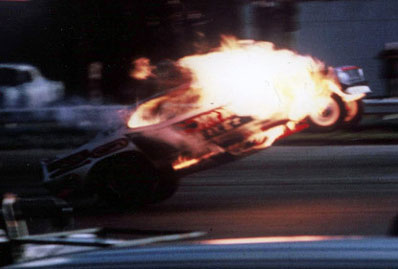 |
I had forgotten that Al Kean, a DRAGSTER Insider regular, had taken the famous shot of Don Prudhomme's Hot Wheels 'Cuda on fire and flying through the lights in Seattle and had actually written the details for me that we ran in ND some years ago, so he had that document handy when I asked him for details.
"The event was the second annual Hot Wheels Northwest National Open at
"Prudhomme had won the previous year’s event (which I had also attended) in Top Fuel, but this year, he was competing in Funny Car. The previous weekend at OCIR, Prudhomme had run the then-quickest Funny Car elapsed time ever at 6.62 seconds. This year, the real drama began in the semifinals when he faced Butch Maas, driving the Hawaiian, owned, of course, by Prudhomme’s old boss, Roland Leong.
"Both cars were loaded up with heavy doses of nitro, and when they launched, they burst several light bulbs on the Christmas Tree! It was the quickest side-by-side Funny Car race in history. The Hawaiian ran a then-great 6.78 only to lose to 'the Snake’s' 6.67 (the second-quickest run in history). The run resulted in a damaged clutch, and the Hawaiian and Whipple & McCulloch teams helped in changing it. The late, great Steve Evans was the announcer that day, and he said on the PA that Prudhomme claimed to be trying to run the first-ever 6.5 in Funny Car history in the final.
"We left our grandstand seats beside the starting line to get closer to the parking lot. We snuck into a very small (but surprisingly empty) VIP grandstand right at the finish line to watch the final rounds. As the event wound down, it was getting very close to the track’s strict 5:30 p.m. curfew. They ran the final round of Top Fuel first because Prudhomme was just pulling into the lanes after his clutch replacement.
"I was taking pictures all day with my dad’s Practica camera with a telephoto lens. This was the first time all weekend that I had an unobstructed shot of the track, and right at the finish line!
Prudhomme was racing Dave Condit in the L.A. Hooker Maverick in the final race of the day. Evans, as always, did a great job pumping up the crowd. After a long, smoky burnout, Prudhomme did a few dry hops over the starting line, and Evans said that they were seconds away from the curfew. I was watching everything through my camera’s viewfinder. The cars staged and launched. I was following the cars, and I thought I saw flames coming out of 'the Snake’s' windows as he neared the finish line. I remember thinking that it must just be glare off something – he couldn’t really be on fire, could he? I kept following the cars and clicked the shutter when they crossed the finish line.
"I then took the camera away from my face and looked downtrack to see Prudhomme’s car, with NO body on it, still in a wheelstand. It was at least 300 feet after the finish line before the car’s front wheels returned to earth. Emergency crews converged on the car. I looked back uptrack to see pieces of the body spread all over the track with fans jumping the fences to get a souvenir. I must admit the body pieces would have been great souvenirs. I saw one guy walking away with almost an entire side of the car that had the intact blue panel with the logos of Hot Wheels, Snake, and so on. My brother said that his eyes actually followed the body as it flew off and up 150 feet into the air before disintegrating as it fell back to earth.
"Prudhomme had won the race at 6.96 to Condit’s 6.98. The race was not that close, though, because Prudhomme broke the finish-line photo cells with the wheelie bars (as you can see in my photo, the rear wheels are also off the ground at the finish line), and Condit did it with the front wheels as normal. In my photo, you can see the front of the L.A. Hooker just entering the picture, a good car length behind.
"I had no idea what I had gotten in the photo. I had to wait several days for the color slides to get developed after we got home. It was pretty exciting to finally see the photo that I had taken. It was also exciting getting all the attention afterwards. The photo was published in Hot Rod magazine, Funny Car Pictorial, SIR programs, etc. Then track manager Bill Donor gave me a photo pass the next year, etc. The photo has also been mentioned in TV shows, over SIR’s PA, etc.
"Prudhomme has been great with me over the years. When I got him to sign a big copy for me, he brought me into his pit, in front of my friends. That certainly made a big impression! When I first brought my son, I got Don to autograph a copy for him. He again brought us both into his pit, showed all of his crew the photo, and treated us like VIPs. All in all, taking that photo was an experience I’ll never forget."

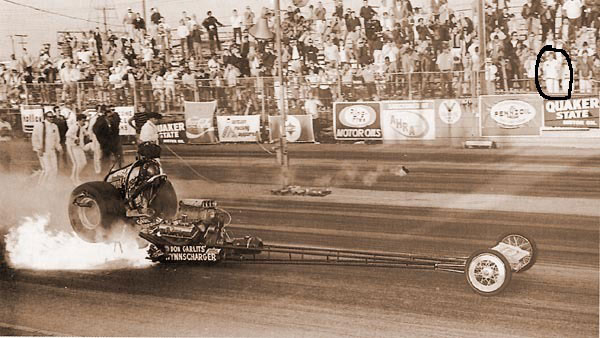 |
And speaking of Lions starting-line explosions, a whole host of people surmised – as I did privately – that the circled fan in this scan of Jon Asher's Garlits explosion photo may have been the fan injured by the shrapnel, some of which keen-eyed readers point out can be seen in the photo. Larry Sutton, who was the starter and who waded into the stands to save the fan's life, confirmed to me that that is the general area where he found the injured spectator, whom Lions historian Don Gillespie indentifies at Tom Ditt.
Greg Liskey, who is a two-time Sportsman Motorcycle champ in Division 7, was there and recalled, "I was 18 and on the pit crew of Dennis Thompson's stocker that day. All decked out in our newly acquired white uniforms, we were lookin' good but unfortunately were eliminated in competition. I headed to the stands to watch the big boys run. I have told lots of people that Lions is the reason I flunked high school.
"As the event headed to a conclusion, I remember Garlits and Richard Tharp pulling to the starting line. It was one of those moments that anyone lucky enough to have ever been there could only describe as 'Lions!' There was electricity in the air. As Tharp and Garlits left the starting line, instantly there was a huge explosion! I watched Garlits' car separate and the cockpit tumble forward just off the starting line. The motor and front of the car swung out and came to a stop just past the Tree. Tharp streaked towards the big end. Everything was in slow motion to the senses."
Terry White also was there with his older brother, in the same stands, just out of the frame downtrack. "We were understandably awestruck by the action on track and paid no attention to what was going on in the stands a short distance from us," he said. "When spectators started yelling at people on the track from the stands to our lower right, we noticed the commotion. On-track personnel, Sutton included, found their way to the stands, and soon another ambulance (one was on the track for 'Big') showed up behind us on the return road. When I see those photos, it takes me back as though it was yesterday."

 |
Other quick takes: Steve Justice says that the great in-car camera shot of Jess Sturgeon was done at Riverside Raceway and that the jet versus Top Fueler photo features J.D. Zink in Romeo Palamides' Untouchable going off against Don "Mad Dog" Cook at
A few people pointed out that the oil-filler cap on the valve cover of Kalitta's SOHC mill was missing in the shot.
Tom Posthuma didn’t have the ID on this car at right but thought it might be from "quite early English drag racing" based on the Ford Cortina in the background, which he thinks might be a '63, and the guy with the coat might be early British drags pioneer Sydney Allard. I've reached out to my buddy across the pond, noted British drag racing reporter Roger Gorringe, and asked him to investigate. I'll let you know what we find out.
Paul Schwan of Cincinnati dropped me a line about Ed Donovan's side-mounted blower, noting, "The 6-71 blower that was originally used was indeed mounted on the side of a 6-71 Detroit Diesel, or before it was Detroit, it was a GM diesel, or affectionately known as a 'Jimmy Diesel.' In either a right- or left-hand 6-71, the side of the engine on which the blower was mounted determined either rotation or direction of the engine; therefore, that mount on the Offy was closer to 'stock' than most people realized."

 |
 |
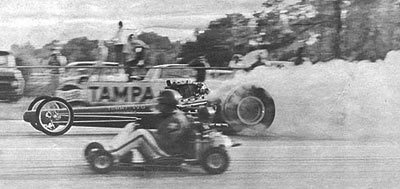 |
And finally, Cliff Morgan and Bill Mays remember that the go-kart in this picture was powered by a small rocket engine on hydrogen peroxide; Bret Kepner swears that the notorious Capt. Jack McClure was at the wheel. Morgan also said that it was Tommy Ivo in the other lane, so I caught up with T.V. (after he woke up to begin his day, as always, on Ivo time, at about 3 p.m.), who, as always, had plenty to say when it came to talking about himself and passed along two bonus photos.
"It sure is me," he confirmed, "but I'm still trying to get the hook out of my mouth on this one. They reeled me in on this -- I guess they noticed the sign I had hanging around my neck that said 'FISH' on it." The "they" in this case were the go-kart makers.
"We were at
"The rocket engine had a heart attack before we could have the race, so the guy with the kart still really wanted to get a picture with me racing him. Soooooooo, he suggested to just set him on the starting line next to me and get the picture when I took off. It wasn't a movie, so who would know if he were running or not? 'Okay, that will work,' I said! But then once again, old Cecil B. De Ivo had to not leave well enough alone. Attempting to make a good idea better (as I always do), I suggested that they put the kart out about 25 feet or so; therefore, I could get up a good plume of smoke behind me to make the picture more dramatic. Wrong!! Here's the shot they were 'supposed' to get!
"BTW, he said the header exhaust about blew him off the go kart when I went past him. I would imagine it was pretty intense with the 'weed sprayers' pointed right at him. They were not your father's zoomies, you understand!
"I was a victim of my own stupidity, it would seem (again), BUT -- and here comes that 'but' again -- I was right; it did make a great shot, didn't it? Here you are, sending a copy of it to me 44 years later!!! I think that falls under the category of it being a 'damned-if you-do-and-damned-if-you-don't' deal."
Ivo also reported that when Tom McCourry was touring Ivo's four-engine car -- running it under Ivo's name for a while for the value of the name recognition in advertising – he got sucked into a similar deal with a rocket-powered VW but that the VW crashed before it got to the other end of the quarter-mile, which Ivo also believed happened at Tampa.
But Ivo, ever the zany and resourceful prankster, says he got back at track operator and good pal Billy Herndon, at whose house he would stay during his bookings there. "The next time I was staying at his house, he got his comeuppance. He had a large pantry with many, many canned goods in it since he had a good-sized family. He wasn't at home when I left, so I took all the labels off of literally hundreds of cans in the pantry. He said it was an adventure every night for dinner. They would shake a can and say, 'What does that sound like?' So they'd open what sounded like a can of peas for the dinner vegetable and end up with dog food or the like. Perfect!"
And with that tale, my DRAGSTER Insider friends, we come to the end of another feast of drag racing stories behind the stories; thanks as always for the dishes you brought to this particular potluck.
























